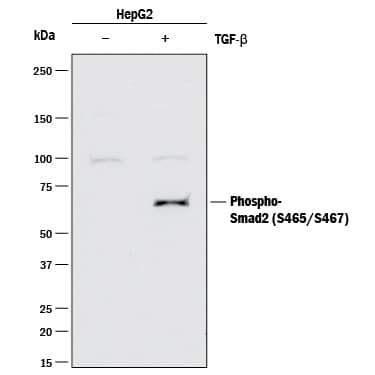Human Phospho-Smad2/3 (S465/S467) Antibody
R&D Systems, part of Bio-Techne | Catalog # MAB8935

Key Product Details
Validated by
Species Reactivity
Validated:
Cited:
Applications
Validated:
Cited:
Label
Antibody Source
Product Specifications
Immunogen
Accession # NP_005892
Specificity
Clonality
Host
Isotype
Scientific Data Images for Human Phospho-Smad2/3 (S465/S467) Antibody
Detection of Human Phospho-Smad2/3 (S465/S467) by Western Blot.
Western blot shows lysates of HepG2 human hepatocellular carcinoma cell line untreated (-) or treated (+) with 10 ng/mL Recombinant Human TGF-beta 1 (Catalog # 240-B) for 30 minutes. PVDF membrane was probed with 2 µg/mL of Rabbit Anti-Human Phospho-Smad2/3 (S465/S467) Monoclonal Antibody (Catalog # MAB8935) followed by HRP-conjugated Anti-Rabbit IgG Secondary Antibody (Catalog # HAF008). A specific band was detected for Phospho-Smad2/3 (S465/S467) at approximately 68 kDa (as indicated). This experiment was conducted under reducing conditions and using Immunoblot Buffer Group 2.Applications for Human Phospho-Smad2/3 (S465/S467) Antibody
Western Blot
Sample: HepG2 human hepatocellular carcinoma cell line treated with Recombinant Human TGF‑ beta1 (Catalog # 240-B)
Reviewed Applications
Read 2 reviews rated 4.5 using MAB8935 in the following applications:
Formulation, Preparation, and Storage
Purification
Reconstitution
Formulation
Shipping
Stability & Storage
- 12 months from date of receipt, -20 to -70 °C as supplied.
- 1 month, 2 to 8 °C under sterile conditions after reconstitution.
- 6 months, -20 to -70 °C under sterile conditions after reconstitution.
Background: Smad2/3
Smads are a family of intracellular proteins that transmit transforming growth factor beta (TGF-beta) superfamily signals from the cell surface to the nucleus. The Smad family is divided into three subclasses: receptor regulated Smads, (Smads 1, 2, 3, 5 and 8); the common partner, (Smad4); and the inhibitory Smads, (Smads 6 and 7). The binding of TGF-beta or activin to their cognate receptor induces phosphorylation of Smads 2 and 3. The activated Smads associate with the common-mediator subunit, Smad4, and the heteromeric complex translocates into the nucleus to initiate transcription. Smad3, also known as Mothers Against Decapentaplegic homolog 3 (MADH3), shares 83% amino acid identity with Smad2, also known as Mothers Against Decapentaplegic homolog 2 (MADH2). Human Smad2 has 99% identity to mouse and rat Smad2. Human Smad3 has 99% identity to mouse and rat Smad3.
Long Name
Alternate Names
UniProt
Additional Smad2/3 Products
Product Documents for Human Phospho-Smad2/3 (S465/S467) Antibody
Product Specific Notices for Human Phospho-Smad2/3 (S465/S467) Antibody
For research use only
